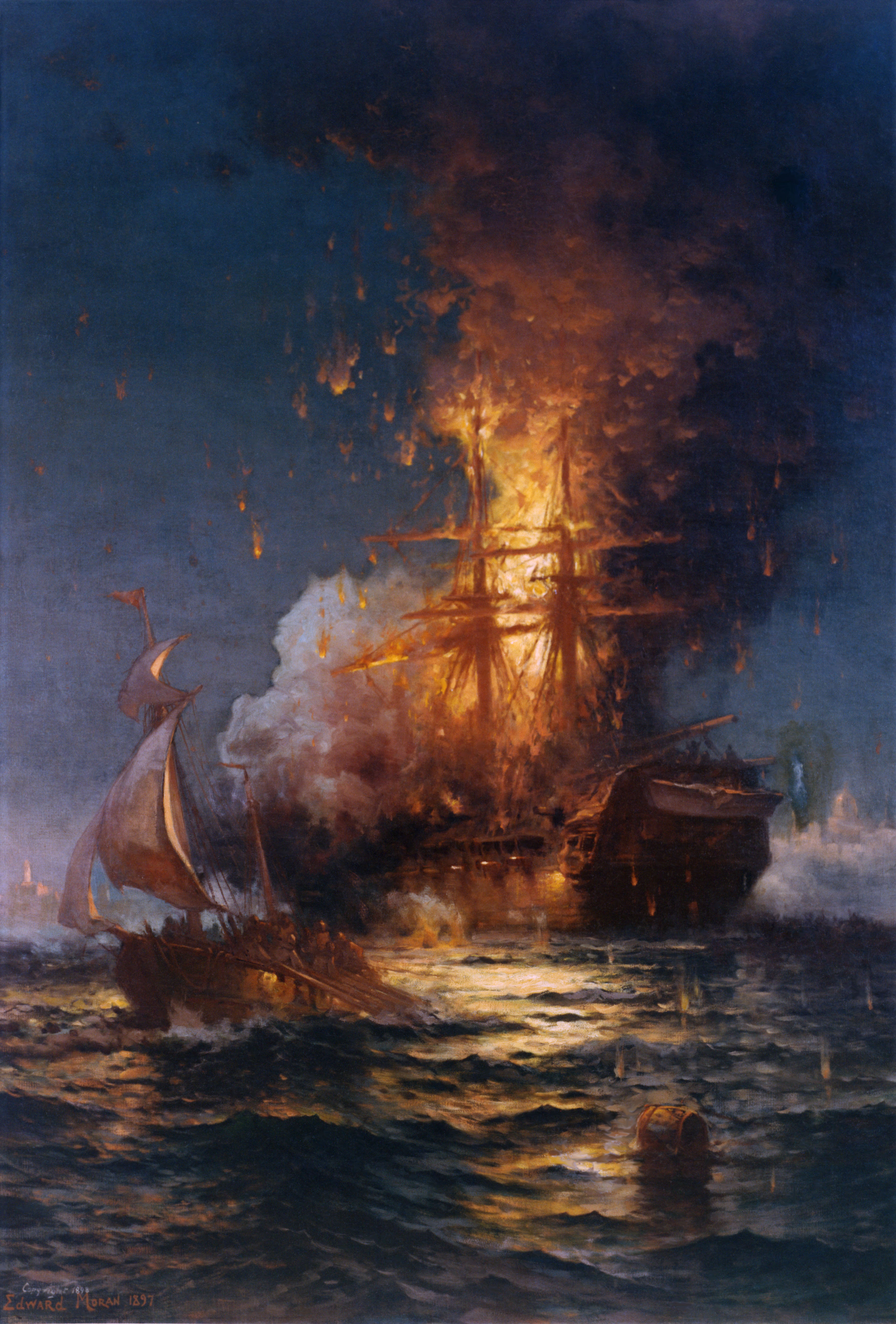 It would seem to go without saying that, if one lives in a self-contained world made almost entirely from wood, one would have to watch out for fire. And if such wood were further coated with tar and/or paint, one would need to be even more cautious. The French ship, Orient illustrates the problem. She got caught in the middle of one of the many interminable paint jobs a ship undergoes in the course of life and the paint that was being applied above deck caught fire. It wasn't the paint that burned down the ship. it was just the fire the paint started. It got into that wood we mentioned earlier and that, ultimately blew up her powder magazines.
So, you'd think that the "wooden walls" represented ocean-going ships, ships made of heavy stock. Sure it wouldn't catch fire from a cigarette butt. Maybe, probably. It still bears paying attention.
One thing that is certain to make the fire happy to stick around is the winning combination of a sustained source of heat, and splinters. Not the kind you get from the firewood. More like these:
It would seem to go without saying that, if one lives in a self-contained world made almost entirely from wood, one would have to watch out for fire. And if such wood were further coated with tar and/or paint, one would need to be even more cautious. The French ship, Orient illustrates the problem. She got caught in the middle of one of the many interminable paint jobs a ship undergoes in the course of life and the paint that was being applied above deck caught fire. It wasn't the paint that burned down the ship. it was just the fire the paint started. It got into that wood we mentioned earlier and that, ultimately blew up her powder magazines.
So, you'd think that the "wooden walls" represented ocean-going ships, ships made of heavy stock. Sure it wouldn't catch fire from a cigarette butt. Maybe, probably. It still bears paying attention.
One thing that is certain to make the fire happy to stick around is the winning combination of a sustained source of heat, and splinters. Not the kind you get from the firewood. More like these:Check out Mr. David "Big Balls" Farragut. Just hangin' out; overplaying it just 'cause the photographers were there.
Enough about him. Take a look at that big chunk of wood in the foreground, laying across the rail, the one that looks to be a lot more deadly than Dave does.
 That's a splinter. That bursting out the bulkhead right next to your head would ruin your entire next... howeverlong.
That's a splinter. That bursting out the bulkhead right next to your head would ruin your entire next... howeverlong.So, a heavy cannon ball hitting the side of a ship would produce these large, pointy projectiles, even if the ball didn't go all the way through.
Cross section of USS Constitution. Outside, the planking runs horizontally while the structural ribs on the inside are vertical. It would be a rare shot that actually punctured the hull. What didn't bounce off would be stuck until further notice.
Stuck like Chuck and stuck surrounded by a nest of the splinters which didn't break loose and decapitate anyone. Let's call those splinters; "kindling."
It seems that if a fella could somehow make these projos hot, seriously hot, then the job of putting the ship under would be greatly aided.
Enter the hotshot furnace.
Mostly found accompanying coastal batteries although a very few were used aboard ship.
 |
| A small furnace used by the Norwegian Navy |
It's pretty straightforward. Balls go in at the top like they would in a giant Marble works, line up on iron rails inside where the heat from a fire at the lower end makes the balls nice and toasty as it passes over them on its way to the flue.
In a lab, kiln-dried red oak will ignite after just half a minute at 800 degrees Fahrenheit - self-cleaning oven temperature. A ship isn't kiln dried, not a huge difference and it's also not red oak. However, as a guideline...
Iron starts to glow just a bit over 1000 but will be over 1500 when it becomes a bright, cherry red.
So, imagine a red-hot ball, taken from the furnace and put down the tube - with a wad of either wet clay or rags as a buffer - and sent downrange.
I'd say - less than a minute from start to finish. All that time our hypothetical ball is losing heat but how much heat?
I'm thinking it would be a significant amount but that it wouldn't matter.
The time spent being trundled from the furnace to the gun, the contact with the barrel and the wad followed by its final trip through the air, have of course cooled it but only on the surface.
Old, ARTY expression: "You've gotta have a lot of balls to justify a hotshot furnace!" It'll be old by the time you read it, older anyway.
Point is: These batteries weren't throwing rounds on any quick schedule so a ball on the bottom row of the furnace may have spent the entire day rolling down there, all the while getting a nice long soak.
So, the ball itself may have even lost its rosy glow at least temporarily all that other cast iron on the inside would be unaffected.
USS Constitution carried 24 and 32-pounders. The coastal batteries would have gone bigger but there's a limit to how much red-hot iron two guys can carry, with tongs, at a run.
Because I seem to lack a purpose in my life but do own a sixteen pound cast iron ball from a ball mill, I stuck it into my propane forge. I then spent twenty minutes running it up to cherry red.
Having been taken out and sitting in the open air it was still perceptibly glowing eight minutes later.
Two minutes after that it didn't look hot at all but a piece of cardboard put next to it caught fire in less than a minute.
So it would appear that when a chunk half again as large or twice as large or larger (I would think a 50 pounder would be the upper limit of manageability) would hold onto its heat even longer.
So it's easy to imagine the sense of urgency 32 pounds of hot iron resting in a nest of kindling would engender on a hugely flammable ship.
What would be needed to be rid of it was the boarding axe.
The pictured example is from the War of 1812.
These are thought of as weapons but in reality they are weapons in much the same way that a hammer would be a weapon in the case of a crew of house framers defending themselves. It could definitely be used as a weapon but its main function was damage control and firefighting.
This bad boy was used for chopping away fouled rigging and spars, and chopping out any hotshot that it may be herded to a nearby scupper.
This prosaic hero is also the direct forerunner to the well known, modern fire axe.
In closing, this has not been just an attempt to bore you with minutiae.
Rather it's a grand product roll out. Places everyone!
Introducing my new and improved Naval Boarding Axe.
Bigger, heavier with more authentic langets!
24 oz head, 23" overall length.
Coming soon.















2 comments:
have a peek at these guysRead Full Article my review hereimp source Homepageblog here
w9z70q7p56 r8k62j4m18 l2z01z6l00 c5z48b5d84 s2h31x9t06 v4v67s8e65
Post a Comment